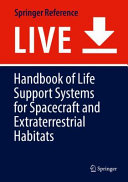

Most ebook files are in PDF format, so you can easily read them using various software such as Foxit Reader or directly on the Google Chrome browser.
Some ebook files are released by publishers in other formats such as .awz, .mobi, .epub, .fb2, etc. You may need to install specific software to read these formats on mobile/PC, such as Calibre.
Please read the tutorial at this link: https://ebookbell.com/faq
We offer FREE conversion to the popular formats you request; however, this may take some time. Therefore, right after payment, please email us, and we will try to provide the service as quickly as possible.
For some exceptional file formats or broken links (if any), please refrain from opening any disputes. Instead, email us first, and we will try to assist within a maximum of 6 hours.
EbookBell Team

5.0
70 reviewsThis reference work gathers all of the latest technologies, information, definitions and explanations of spacecraft life support systems, while providing in-depth coverage of the current knowledge of the business of keeping astronauts alive during their missions. It is intended that this MRW be the go-to reference work not only for aerospace engineers, but also for graduate and undergraduate aerospace engineers and space scientists. The area of spacecraft life support is comprised of dozens of specialties and sub-specialties within the fields of engineering, biophysics and medicine. As space agencies around the world pursue cutting-edge life support technologies, much more information and data is accumulated. When humans move out into the solar system to stay for long durations, the most immediate challenge will be the provision of reliable and robust life support systems in locations devoid of food, air and water. These life support systems must provide these commodities in each phase of spaceflight, including intra-vehicular activity (IVA) and extra-vehicular activity (EVA). Systems supporting human life must also fulfill myriad requirements: exceptional reliability in the space environment, allowing maintenance and component replacement in space; reduced resupply mass of consumables and spares; the ability to utilize local planetary resources for self sufficiency; and minimized mass power and volume requirements. These requirements will assume ever greater importance as bolder missions are envisioned and more sophisticated life support systems are required. For example, the next decade could see human missions to Mars and a return to the Moon. In the not-so-distant future, there is the prospect of Mars One and the creation of a permanent extraterrestrial colony. It may appear that a suitable environment can be created simply by reproducing terrestrial environmental conditions within a vehicle. In reality, it is first necessary to define the environmental characteristics humans require and match these requirements with the myriad design constraints. This is no easy task, because implementing these environmental parameters within a spacecraft can be challenging, while balancing the various requirements and constraints can test the abilities of even the most gifted aerospace engineer. Yet it is a crucial field of study and the experts contributing to this volume are on the very front lines.